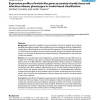182 search results - page 32 / 37 » Activity recognition using temporal evidence theory |
JKM
2007
13 years 7 months ago
2007
Purpose – The purpose of this paper, drawing as it does on earlier research, is to provide the context for a discussion on the use of rewards and recognition programmes in knowl...
BMCBI
2008
13 years 7 months ago
2008
Background: Large-scale compilation of gene expression microarray datasets across diverse biological phenotypes provided a means of gathering a priori knowledge in the form of ide...
NN
1998
Springer
13 years 7 months ago
1998
Springer
The selection and control of action is a critical problem for both biological and machine animated systems that must operate in complex real world situations. Visually guided eye ...
EUROSSC
2009
Springer
14 years 2 months ago
2009
Springer
A major challenge in using multi-modal, distributed sensor systems for activity recognition is to maintain a temporal synchronization between individually recorded data streams. A ...
SAC
2009
ACM
14 years 2 months ago
2009
ACM
In this paper we propose an attention-based vision system for the JAST interactive dialog robot. The robotic vision system incorporates three submodules: object recognition, gestu...

